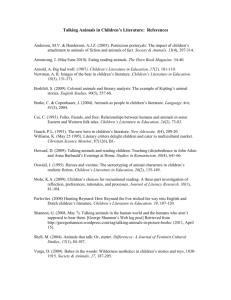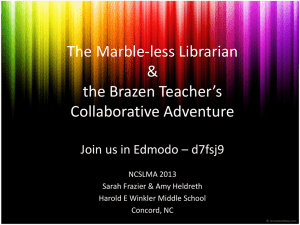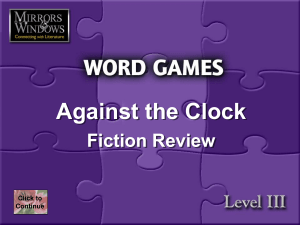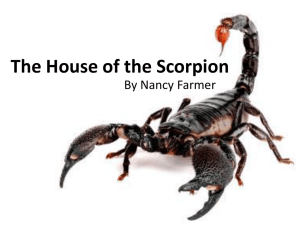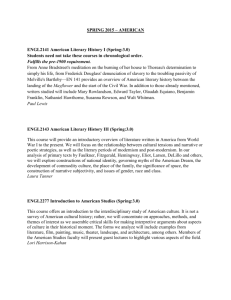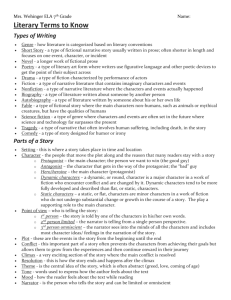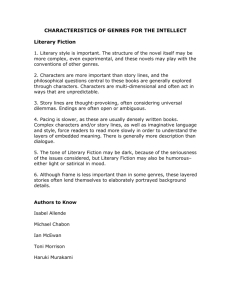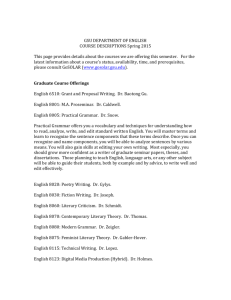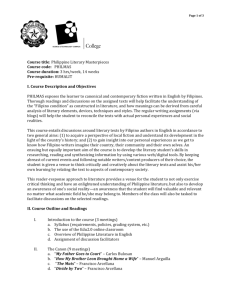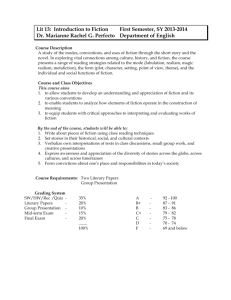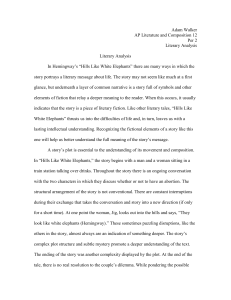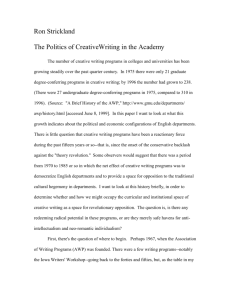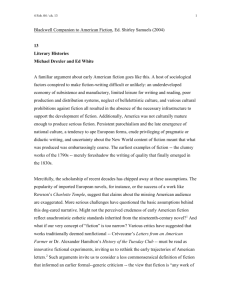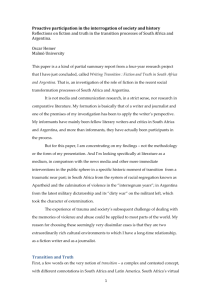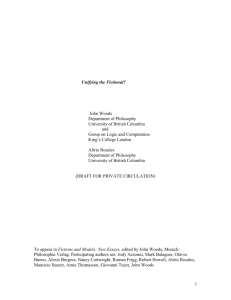Course No: ENG104 - Rogue Community College
advertisement
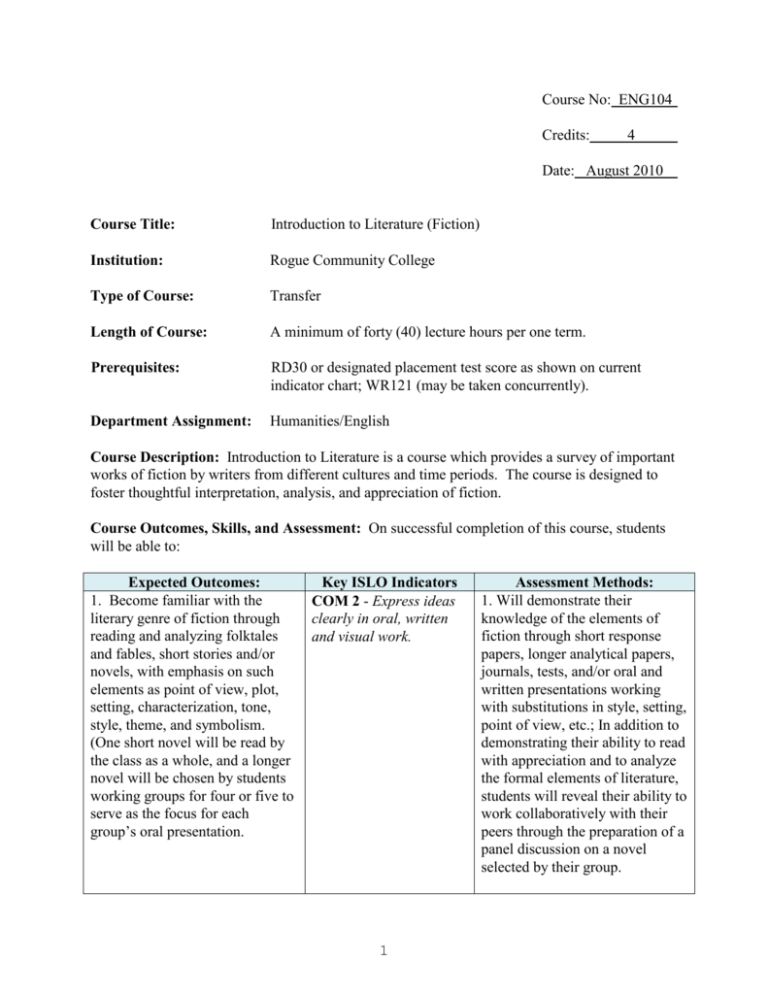
Course No: ENG104 Credits: 4 Date: August 2010 Course Title: Introduction to Literature (Fiction) Institution: Rogue Community College Type of Course: Transfer Length of Course: A minimum of forty (40) lecture hours per one term. Prerequisites: RD30 or designated placement test score as shown on current indicator chart; WR121 (may be taken concurrently). Department Assignment: Humanities/English Course Description: Introduction to Literature is a course which provides a survey of important works of fiction by writers from different cultures and time periods. The course is designed to foster thoughtful interpretation, analysis, and appreciation of fiction. Course Outcomes, Skills, and Assessment: On successful completion of this course, students will be able to: Expected Outcomes: 1. Become familiar with the literary genre of fiction through reading and analyzing folktales and fables, short stories and/or novels, with emphasis on such elements as point of view, plot, setting, characterization, tone, style, theme, and symbolism. (One short novel will be read by the class as a whole, and a longer novel will be chosen by students working groups for four or five to serve as the focus for each group’s oral presentation. Key ISLO Indicators COM 2 - Express ideas clearly in oral, written and visual work. 1 Assessment Methods: 1. Will demonstrate their knowledge of the elements of fiction through short response papers, longer analytical papers, journals, tests, and/or oral and written presentations working with substitutions in style, setting, point of view, etc.; In addition to demonstrating their ability to read with appreciation and to analyze the formal elements of literature, students will reveal their ability to work collaboratively with their peers through the preparation of a panel discussion on a novel selected by their group. Expected Outcomes: 2. See the value of traditional and contemporary critical approaches to literature, such as the biographical, moral/philosophical, formalist, psychoanalytical, mythological or archetypal, Marxist, feminist, deconstructionist, readerresponse, and new historicism. Becoming familiar with these approaches will aid the student in the process of close reading and independent analysis. 3. Acquire knowledge of literary movements and connect them with pertinent social and historical movements. Key ISLO Indicators CT 2 - Raise significant and relevant questions. COM 2 - Express ideas clearly in oral, written and visual work. Assessment Methods: 2. Students will use techniques from different schools of literary criticism in oral and written discussions of short stories and novels, occasionally interpreting the same work from two or three different theoretical vantage points. CT 2 - Raise significant and relevant questions. CT 3 - Locate, organize, analyze, and interpret data. COM 2 - Express ideas clearly in oral, written and visual work. 3. In papers of literary analysis, students will cite passages from their reading to indicate their awareness of such movements as romanticism, realism, naturalism, modernism, and their impact on the form and focus of literary works; Students will achieve 75 percent or better on a written test over this material. They will demonstrate this knowledge in class discussions and/or panel presentations. 4. Learn to examine the way their own experiences and expectations shape their reading of texts, and to apply to their own situations the philosophical and psychological insights gleaned from literary fiction. CT 1 - Recognize own and others’ emotions, assumptions, biases, and cultural contexts. COM 2 - Express ideas clearly in oral, written and visual work. 4. Students will produce at least four reaction papers, keep a reading journal, and engage in regular class discussions and small group interactions. 5. Heightened awareness of the part gender, race, and culture play in literary expression. COM 2 - Express ideas clearly in oral, written and visual work. 5. Students may create a dramatic situation to present to the class, demonstrating how a given work might be changed if the gender, race, time and place were different in a particular work. Some of these may be videotaped and exchanged with other sections of ENG104. 2 Expected Outcomes: 6. Drawing on collaborative learning, students will develop an increased ability to communicate, both orally and in writing, their insights into the literary works covered and an enhanced ability to appreciate and evaluate the responses of their classmates. Key ISLO Indicators CT 1 - Recognize own and others’ emotions, assumptions, biases, and cultural contexts. COM 2 - Express ideas clearly in oral, written and visual work. COM 3 - Collaborate effectively to achieve course/learning goals. Assessment Methods: 6. At least once a week, students will be asked to write a short response to one question over the assigned reading. Working in groups, students will evaluate responses produced by their classmates and select especially informative or thoughtful responses to share with the rest of the class. Typical Required and Recommended Textbook(s): Kennedy, X.J., and Dana Gioia. Literature: An Introduction to Fiction, Poetry, and Drama, 9th ed. Format: A combination of lecture, class discussion, and group activities. Short quizzes, reading journals, and response papers based on reading. Approximately two substantial analytical papers. Midterm and final exams. TYPICAL COURSE OUTLINE: 1. 2. 3. 4. 5. 6. Reading a Story Point of View Character Setting Tone and Style Theme 7. 8. 9. 10. 11. 12. Symbol Evaluating a Story Reading Long Stories and Novels A Writer in Depth Stories for Further Reading Criticism: On Fiction 3

